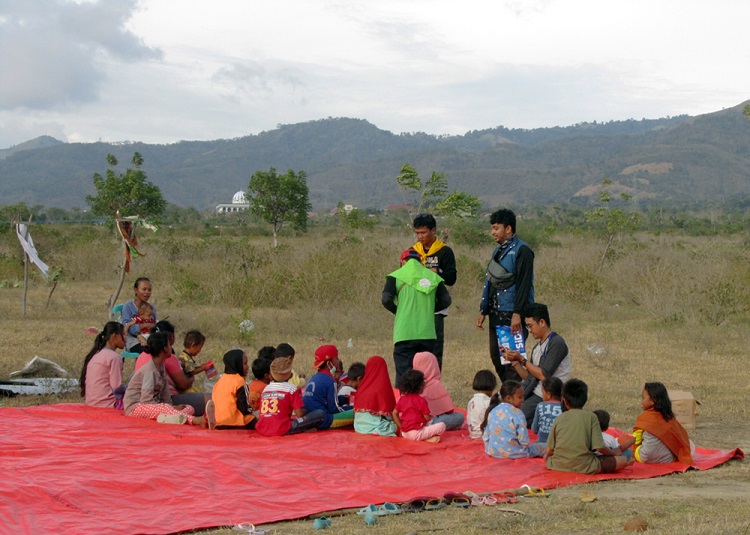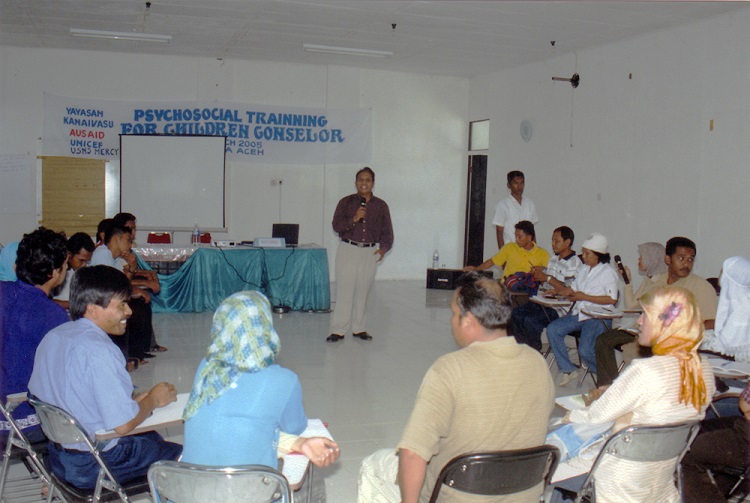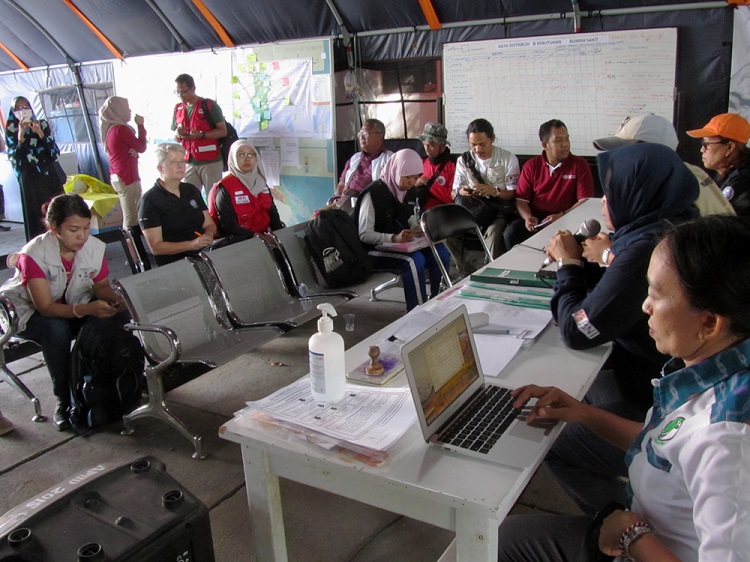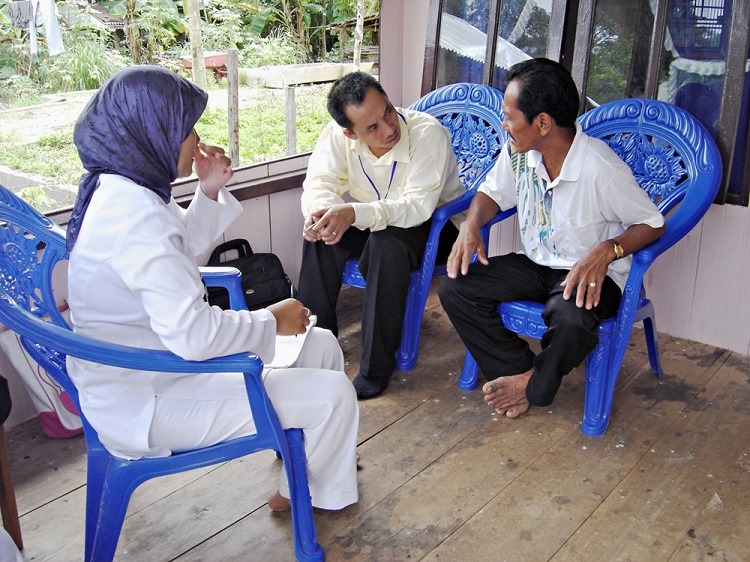Versi Bh. Indonesia
Mental health and psychosocial support in the wake of disaster
Albert Maramis
Every time I am called to respond to a natural disaster, I am struck by the magnitude of the devastation; how powerful the forces of nature can be. Every time I have participated in a disaster response and helped local authorities to organise their efforts in the field – from the tsunami in Aceh in 2004, the massive earthquake in Bantul in 2006, the earthquakes in Bengkulu in 2007 and in Padang in 2009, until the recent Palu earthquake and Banten tsunami in 2018, I have learnt something new. Disaster response programmes have improved over the years, but much remains to be done to be better prepared for disasters, and especially in terms of mental health, because the risk of such disasters occurring again remains high.
Indonesia lies on the Ring of Fire. It is located between two continental plates: the Eurasian Plate (Sunda Plate) and Australian Plate (Sahul Shelf), and between two oceanic plates: the Philippine Sea Plate and the Pacific Plate. This unique geographical location puts Indonesia at a very high risk of natural disasters. Earthquakes and volcanic eruptions occur more frequently in Indonesia than anywhere else. Other kinds of disasters, both natural and non-natural, occur frequently as well. These disasters often lead to death and injury, but they can also severely affect the mental health of survivors.
During the last five years there have been 10,969 disasters, which have affected 18,304,324 people, and caused 6,485 deaths and 26,910 injuries. Indonesian National Disaster Mitigation Agency (BNPB) data also shows that 1,729,490 homes, 589 health facilities, and 5,239 schools were damaged.
Impact on mental health
After a natural disaster everyone living in the area in which the disaster occurred will be affected. Most of them will be in distress. Their distress can be caused by past events, the present, and fear for the future. Traumatic memories include the earthquake itself, injuries suffered, destruction of property, loss of possessions, and the death of loved ones. In the immediate aftermath of a disaster many face a raft of challenges including instability, insecurity, inappropriate living conditions, environmental threats (climate, dangerous animals, etc.), unsafe or inadequate bathing or toilet facilities, threats of violence, theft, or sexual violence, loss of livelihood and income, and the loss of child support and education. At the same time, aside from these practical and immediate concerns, worries about the future can also be a source of distress: uncertainty, instability and insecurity, a loss of hope, and the questioning of religious beliefs.

Among survivors of natural disasters there will always be a number of individuals with pre-existing mental disorders, such as psychosis or schizophrenia, depression, bipolar disorder, anxiety disorder, and other chronic mental illnesses. Their medication will run out sooner or later and this increases the risk of worsening their condition. Other individuals will develop a mental disorder for the first time, such as acute stress reaction and post-traumatic stress disorder. Their condition can become so severe that these individuals might need medical and emergency care. It is detrimental to focus only on trauma and PTSD in the aftermath of disasters; many other mental disorders will also be present and, at times, in an exacerbated form.
Providing support
The term mental health and psychosocial support (MHPSS) was introduced fifteen years ago to provide comprehensive mental health support to the survivors of disasters. MHPSS comprises many kinds of interventions, but usually includes the protection and promotion of psychosocial wellbeing as well as the prevention and treatment of mental disorders. Because social interventions affect psychological states and vice versa, the term ‘psychosocial’ is used. In short, both social and psychological aspects are taken into account.
Social interventions include providing a flow of credible information with respect to risk communication, family tracing and reunion, field officer briefings, and setting up shelters. Social interventions also include involving the community in planning and decision making, organising funeral ceremonies, re-establishing economic, cultural, and religious events, providing normal recreational activities for children as well as reopening schools.
Psychological interventions range from making psychological first aid (PFA) available in the community, detecting and managing severe and disabling psychological conditions, collaborating with local community health centres (puskesmas) and emergency services to manage urgent psychiatric conditions, ensuring the supply of essential medicines for the treatment of mental illness, to establishing a referral system for individuals with severe mental illness who cannot be treated by the community health care services. During the acute emergency phase, PFA is an effective method of peer support carried out by lay people or non-specialists, to attend to acute mental health problems that arise from exposure to extreme stressors.

In most areas affected by disaster, there is insufficient professional manpower, especially medical specialists. Support and services must be organised efficiently to best utilise the few mental health specialists available, whether they are psychiatrists, psychologists, nurses, social workers, or counsellors. Services have to be organised in layers following the Inter-Agency Standing Committee (IASC) Guidelines on Mental Health and Psychosocial Support in Emergency Settings.
The first layer focuses on establishing security, maintaining adequate governance, and providing all services needed to cover basic physical needs. The second layer focuses on supporting the local community and families, for example by providing family tracing and reunification, assisted mourning and communal healing ceremonies, mass communication of constructive coping methods, supportive parenting programmes, formal and non-formal educational activities, livelihood activities, and the (re-)activation of social networks. The third layer includes focused, non-specialised supports targeting a smaller number of people who require more intensive individual, family, or group interventions by trained and supervised workers. These interventions include PFA and basic mental health care by primary health care workers. The top layer includes specialised services for a small percentage of the population whose condition needs urgent attention because of a significant impairment in everyday activities, despite the presence of other layers of support. Such support includes psychological or psychiatric attention and referral services for individuals with severe mental disorders.
Mental health professionals respond
When disaster strikes, the National and Sub-national Disaster Management Agency (BNPB) adjusts its response and the level of aid according to the calibre and type of disaster. In each case, mental health professionals will be among the volunteers and emergency aid workers who are deployed to the affected area; clinics, mental hospitals, universities, and other institutions will send supplies and response teams to the affected area.
The support programmes and types of interventions provided to both natural disasters and non-natural disasters (such as riots, bombings), are essentially similar. The main difference is in terms of preparations for these programmes and interventions, and, because the security threats and risks are different, it determines security precautions in the field.

In the last several years, I have seen an increased willingness among all stakeholders to collaborate and coordinate their activities. This is a promising change, because without adequate coordination, collaboration, data collection, and data analysis, responses will be less effective and efficient. MHPSS teams should be distributed to areas in need. Their activities should be planned to ensure continuity of service at least until the emergency phase has passed. Central to all disaster responses is the command or coordination post, which provides and organises all activities. If local capacity to staff the coordination post is weakened due to the disaster, then personnel from a higher level of government or from the national level will assist. Additional support may also be available through UN agencies, professional organisations, or non-governmental organisations.
Besides providing direct support to the community another important objective for MHPSS teams is to support the existing health and social service system by linking their programs with each other. Capacity building of local staff is a moral obligation. We must remember that the presence of aid teams is only temporary. It is therefore beneficial in the long run for programs to be planned and implemented with the ultimate goal of leaving behind a better situation than that which existed before disaster struck.
Albert Maramis (almarams@yahoo.co.uk) is associated with the Section on Community Psychiatry of the Indonesian Psychiatric Association. He served as a mental health programme officer with WHO Indonesia from 2005 to 2013.
